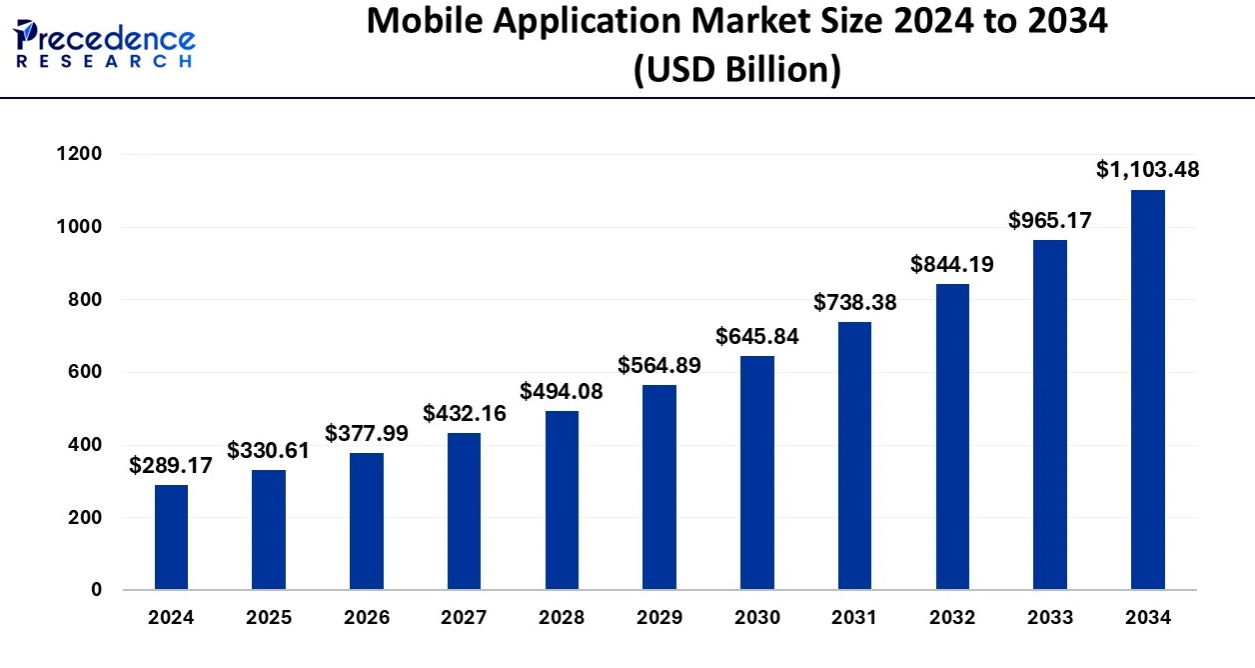Quick Summary :- This blog on React Native shows us why it is the preferred framework for some top brands for developing apps. With features like better performance and ease of use, RN is growing and we have analyzed what to expect from React Native in 2025. Here, we also explore the future of React Native focusing on the factors that drive its growth.
From the amazing Facebook to the cool game PubG and from Uber to the supercool Instagram, what is common in all of them? The Javascript! A technology powerhouse that has given the best of app development frameworks. Today, we will analyze the Future Of React Native.
So, it will not be surprising if you consider the React Native community to be the next big framework in the app development world. The React Native framework for the mobile app market.
The mobile app revenue is expected to show an annual growth rate (CAGR 2025-2034) of 21.55%, resulting in a projected market volume of US$1,103.48bn by 2034.

React Native Performance has gone to a roof in the last few years or so. Thus, it will be interesting to see how the future of react native eventually pans out.
It might look a valid question as React Native future depends on wider adaptations of the JS library. So, let’s find out some answers!
Why React Native is Gaining Popularity?
The most valid question around the app development circles is- “Are React developers in demand?” Because we have seen in the past that many frameworks flourish and then become obsolete.
So, getting above the learning curve and investing time for a framework should have a better prospectus. React Native has a bright future. Because it is not only supported by Facebook but a huge community of developers.
According to the Stack Overflow Developer Survey 2023, React Native is among the most popular frameworks for mobile app development, with 9% of professional developers using it. This continued usage highlights its relevance and strong developer support in 2024 and beyond.
From the earlier releases to the latest version, React Native has seen a kind of evolution. This is why businesses are actively looking to hire React Native app developers, as their demand continues to rise.
Factors That Drive The Growth Of React Native
We saw how the framework is so popular. But, what are the factors that make it more attractive for developers?
Better Performance
Facebook created this framework as a part of its hackathon, but, over the years it has been phenomenal. Especially if you consider a Javascript-based framework, then React Native is one of the best with faster loading applications.
React Native provides a plethora of native UI components, boilerplate codes, and native environments that can help you with native-like apps. These apps are faster and more advanced. These apps are also quite interactive with the user and provide amazing UX.
Hire dedicated developer India to boost your application development and build reliable solutions with assured support from developers even after the project deployment.
Code-Sharing Bliss
If you want to reach more audiences, you need to create separate apps for Android and iOS. That means double development time and double the cost. But with the React Native community of cross-platform developers, you can save time as well as money.
Many companies choose React Native due to its capability of code-sharing. Developers can share as much as 90% of the source codes across platforms.
It helps businesses to reduce the Software development costs by 50-80%. So, businesses can invest more in their products than just development purposes.
Codesharing is great for your business not just for the most part, but, it can help you achieve better UX. It is the reason why React Native developers are in demand. Companies can leverage this to create powerful apps with native UX through React Native.
React Native For Existing App
React Native is awesome and you will love to use it for your existing apps too. But, there is a little catch here. You can use Cordova-based codes for using the React Native framework for your existing apps.
But in 2025 Instead of using Cordova, developers can now use Expo and the React Native CLI to integrate React Native into existing apps. These modern tools make it easier to add native features to your existing apps.
The Real Deal is Javascript
Javascript is the real silo behind the React Native. So, if you are looking for React Native developers for cross-platform apps, then you should demand JS expertise.
Javascript has been the powerhouse that brought many different technologies. So, finding developers with Javascript knowledge in the React Native community is not that hard.
Compatible Features
We have already seen how React Native offers compatible features for Android and iOS. But, the React native future will be more amazing than ever.
We will see the rise of React Native with compatibility to other platforms like Windows, macOS, Linux, tvOS, watchOS, and many more.
Empower React Native Community
The React Native community has been growing since its inception. There is a whole set of forums and discussion panels in the Github repository.
According to Sophie Alpert, the Engineering Manager at React:
“We know that some teams are looking for more thorough documentation in topics like startup optimization, where our expertise hasn’t yet been written down. Expect to see some of these changes over the coming year.”
Early on, Facebook established the react-native-releases repository, creating a centralized library for all major updates to the React Native framework. This initiative laid the foundation for ongoing community collaboration and continues to serve as a key resource for developers working on React Native.
Additionally, Facebook created a dedicated discussions repository, allowing contributors to propose ideas, discuss features and drive improvements. This platform enables transparent communication between developers and provides a space to shape the future of the framework.
Today, these repositories play a big role in ensuring React Native evolves with the needs of its growing community, a space for technical discussions and innovative contributions.
The Ease of Web Apps
You don’t need long code lists for your web applications development. Mobile apps are great and there is no way to ignore it. But, why not extend your already built websites to the world of smartphones with native wrappers.
That’s where a React Native framework can help you find the best releases of web-apps.React Native allows businesses to build mobile-first applications, with the ability to extend some of these apps to web platforms using React Native for Web. So React Native is a great choice for both mobile and cross-platform app development.
Read also: 25 Of The Best React Native Open Source Apps & Projects
During the React native EU in 2019, Emily Janzer laid out a complete plan on phase-wise changes of React Native framework in 2025.
Phase One: Native Modules

The first phase will be focussed on the native modules for the cross-platform apps.
- Type-safe – An improvement over the safety of codes that you share between JS and native platforms.
- Less overhead – It will help reduce the callback overloads between Javascript and native environments.
- Faster Startup – It will reduce the initialization of native apps by default for faster loading apps.
Phase Two: Fabric
Fabric is a project by Facebook. It will change the React Native future. Fabric is a project to make React Native community and its tools more compatible with other platforms than the normal iOS and Android.
It will help create a lower overload on the app architectures and your apps will run faster than the old cross-platform apps in react.
Single Thread: A thread is a channel through which the system communicates to users. A user interface or UI is a medium to interact with the users.
To each user request, a UI has to go through three different threads. But, Fabric will help UI to communicate through callbacks across the Javascript.
Async Bliss: We have seen how asynchronous rendering works wonder. We saw it with Node.Js in the Javascript universe.
But, now with Fabric, it is going to be a reality of React Native in the future releases. Fabric will help the incorporation of async rendering in React Native.
Native Bridges: We have often seen that cross-platform apps struggle due to the gap between the shared code and native environments.
To enhance the debugging of such bugs, you need native bridges. Fabric will provide a simplified native bridge between the JS and Platforms.
It is a new single thread method that will enhance the UI for better interactions. It will provide:
- A native bridge between JS and OS platforms
- Improved user experience through highly reactive UIs
- Better code sharing with debugging capabilities
- Rapid loading mobile apps
Phase Three: New API
With the last phase of 2020, Facebook will be using the early releases of React Native like the new renderer(Fabric) and the native modules to create an initialization path.
It will help achieve faster apps. So, React Native will be faster to load and create rapid apps for your business. So, you can say that it is an upgrade that can change the future of React Native.
One of the most essential upgrades to watch out for in the React Native community is JavaScript Interface JSI. It is an interesting way to connect with the Javascript engine
It helps developers to connect with the engine while writing codes in C++. You can even use APIs like JSC and Hermes. You can use it for:
- Creating Javascript runtime
- Loading of JS bundle
- Callback functions for JS and C++
- Creating the JS objects and accessing them through C++
Top Brands Using React Native
React Native was introduced back in 2015 by Facebook. It was developed to support UI creation for mobile applications across platforms like Android and iOS.
It is an open-source framework that provides unique boilerplate codes, UI components, and other IDE tools for app creation. Javascript has been the pioneer of such frameworks and backed the React Native community.
Some of the bigger names in the business world that use React Native for app development.
- Tesla
- Skype
- SoundCloud Pulse
- Uber Eats
- Walmart
- Facebook Ads Manager
- Airbnb
- Bloomberg
- Baidu Mobile
Conclusion
React Native continues to prove itself as a powerful framework—not just for building mobile apps, but also for delivering robust, enterprise-grade solutions. With its strong backing from Meta and a thriving open-source community, React Native is evolving rapidly to meet the performance, scalability, and development needs of 2025 and beyond.
As the community grows and more exciting features are released, React Native will remain a go-to choice for businesses and developers looking to build high-performance apps with a unified codebase.
Whether you’re a startup or an established enterprise, staying up to date with React Native’s roadmap will give you a competitive edge in the mobile development landscape.
-
Is React Native still popular in 2025?
Yes, React Native remains one of the top choices for cross-platform app development due to its performance, scalability, and strong community support.
-
Will React Native replace native app development?
Not entirely. While React Native simplifies cross-platform development, native development is still preferred for performance-critical and highly customized applications.
-
What makes React Native a good choice for the future?
Its reusable codebase, growing ecosystem, and ability to deliver near-native performance make React Native ideal for future app development projects.
-
Which big companies use React Native?
Leading companies like Meta, Walmart, Shopify, and Microsoft use React Native to build scalable, high-performance mobile applications
-
How is React Native evolving in 2025?
React Native is integrating advanced tools like Fabric architecture, TurboModules, and improved TypeScript support to enhance speed, flexibility, and developer experience.



